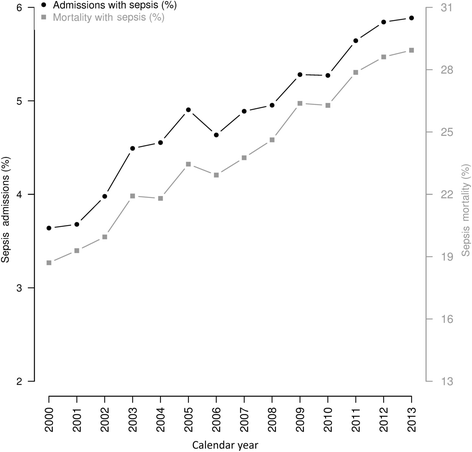Epidemiological trends of sepsis in the twenty-first century (2000-2013): an analysis of incidence, mortality, and associated costs in Spain
- PMID: 29433513
- PMCID: PMC5809921
- DOI: 10.1186/s12963-018-0160-x
Epidemiological trends of sepsis in the twenty-first century (2000-2013): an analysis of incidence, mortality, and associated costs in Spain
Abstract
Background: Sepsis has represented a substantial health care and economic burden worldwide during the previous several decades. Our aim was to analyze the epidemiological trends of hospital admissions, deaths, hospital resource expenditures, and associated costs related to sepsis during the twenty-first century in Spain.
Methods: We performed a retrospective study of all sepsis-related hospitalizations in Spanish public hospitals from 2000 to 2013. Data were obtained from records in the Minimum Basic Data Set. The outcome variables were sepsis, death, length of hospital stay (LOHS), and sepsis-associated costs. The study period was divided into three calendar periods (2000-2004, 2005-2009, and 2010-2013).
Results: Overall, 2,646,445 patients with sepsis were included, 485,685 of whom had died (18.4%). The incidence of sepsis (events per 1000 population) increased from 3.30 (2000-2004) to 4.28 (2005-2009) to 4.45 (2010-2013) (p < 0.001). The mortality rates from sepsis (deaths per 10,000 population) increased from 6.34 (2000-2004) to 7.88 (2005-2009) to 7.89 (2010-2013) (p < 0.001). The case fatality rate (CFR) or proportion of patients with sepsis who died decreased from 19.1% (2000-2004) to 18.4% (2005-2009) to 17.9% (2010-2013) (p < 0.001). The LOHS (days) decreased from 15.9 (2000-2004) to 15.7 (2005-2009) to 14.5 (2010-2013) (p < 0.001). Total and per patient hospital costs increased from 2000 to 2011, and then decreased by the impact of the economic crisis.
Conclusions: Sepsis has caused an increasing burden in terms of hospital admission, deaths, and costs in the Spanish public health system during the twenty-first century, but the incidence and mortality seemed to stabilize in 2010-2013. Moreover, there was a significant decrease in LOHS in 2010-2013 and a decline in hospital costs after 2011.
Keywords: Case fatality rate; Cost; Epidemiology; Hospital resources; Length of hospital stay; Mortality; Sepsis.
Conflict of interest statement
Authors’ information
Not applicable.
Ethics approval and consent to participate
This study involves the use of patient medical data from the Spanish Minimum Basic Data Set (MBDS), which is hosted by the Ministry of Health Social Services and Equality (MSSSI). The MBDS is regulated by Spanish law, which explains how institutions are required to utilize health-related personal data. The data were treated with full confidentiality accord6ing to Spanish legislation. The MSSSI evaluated the protocol of our investigation and considered it to meet all ethical aspects according to Spanish legislation. Given the anonymous and mandatory nature of the dataset, it was not necessary to obtain informed consent. Furthermore, our study was approved by the Research Ethic Committee (Comité de Ética de la Investigación y de Bienestar Animal) of the Instituto de Salud Carlos III (Madrid, Spain).
Consent for publication
Not applicable.
Competing interests
The authors do not have any commercial or other association that might pose a conflict of interest.
Publisher’s Note
Springer Nature remains neutral with regard to jurisdictional claims in published maps and institutional affiliations.
Figures





References
Publication types
MeSH terms
Grants and funding
LinkOut - more resources
Full Text Sources
Other Literature Sources
Medical

